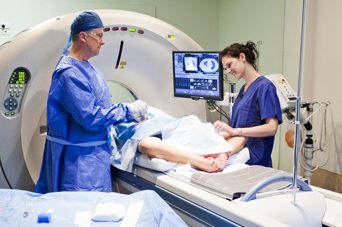 Radiology practices face a host of challenges, ranging from documentation, reimbursement and regulation to burnout and team performance. Today, outsourcing is helping to tackle many of these issues, with radiologists relying on third party service providers for revenue cycle management solutions, radiology transcription, and other services. However, as healthcare providers who spend a lot of time working directly with patients, radiologists need to prioritize patient comfort and satisfaction.
Radiology practices face a host of challenges, ranging from documentation, reimbursement and regulation to burnout and team performance. Today, outsourcing is helping to tackle many of these issues, with radiologists relying on third party service providers for revenue cycle management solutions, radiology transcription, and other services. However, as healthcare providers who spend a lot of time working directly with patients, radiologists need to prioritize patient comfort and satisfaction.
What are the dimensions of patient- and family-centered care (PFCC)? A 2015 article in Radio Graphics lists the features of a patient-centered model as follows:
- Radiologists partner with patients and families to recognize and meet patients’ needs and preferences.
- Providers respect patients’ values and preferences, focus on meeting their emotional and social needs, and involve them and their families in decision making.
- Health care services are coordinated in a way that all members of the clinical care team have access to critical information, and clinical support services are designed to meet patients’ needs.
- Health care providers treat patients with respect and communicate with them effectively, encouraging them to discuss psychosocial issues and providing information and counseling.
- Patients’ are encouraged to ask questions and provided with information they need to make informed health care decisions; this promotes an open doctor-patient relationship in which patients take greater responsibility for their own health.
- Adequate measures are taken to minimize pain caused by the illness and a physical environment is created to promote healing and well-being.
Let’s see how these conditions come into play in radiology and how providers can develop radiology-specific processes that cater to patients’ needs and preferences.
- Effective communication: The Radiological Society of North America (RSNA) first recognized the need to promote patient-centered radiology in 2005. However, a 2015 survey revealed a breach between what radiologists considered important and what they actually practiced. Though 71 percent of respondents agreed it was important to be available to patients for questions immediately post-exam, only 49 percent reported their practice often made arrangements to do so.Technologists play a central role in the radiology department and need to communicate effectively with patients when taking histories, verifying patients’ identity and the procedure to be performed, and screening for safety. They also have to makes sure that patients understand all instructions, answer questions promptly and accurately, and explain post-exam care. Therefore, improving technologists’ communication skills is critical to promoting patient satisfaction and safety.
- Customized imaging: A recent article in Radiology Business stresses the importance of personalizing patients and their images. This is important not only from the patient’s viewpoint but also to help radiologists avoid burnout and improve care. Radiologists need to approach each patient’s case empathetically by personalizing images. This will keep the patient at the center of care.
- Empower radiology staff: A 2017 article in Radiology Business stresses that easing the pressure on the radiology team is important to enhance the patient’s overall experience. Imaging technologists guide patients and their families through stressful situations. If they are preoccupied by the complexity of image acquisition, under pressure due to an excessive workload, or distracted by reporting tasks, the patient experience can suffer. Therefore, reducing technologists’ stress is necessary to help them do a better job of improving the patient’s overall experience within the imaging suite. The author recommends that the use of advanced technologies such as ‘smart’ clinical applications and intelligent software can make the technologist’s job easier and improve the patient experience.
- Patient education: The Radiologic Society of North America (RSNA) and the American College of Radiology (ACR) sponsor the Radiology Info website which provides patients with information on procedures related to diagnostic imaging, interventional radiology, and radiation therapy. Patients can get information on the common uses of the procedures, how to prepare for them, and view images of the equipment used during various procedures. This helps patients prepare for their radiologic procedure ahead of time. Radiologists and radiology organizations have the responsibility to develop, update and maintain these patient education resources.
 Workforce diversification and education: Radiology has a shortage of minority and female physicians and this may be a cause of concern among patients and their families. In an article published in the Journal of the American College of Radiology, experts suggest that hospital departments and imaging centers should recruit a more diverse provider team. This could be an important step towards making it easier for patients and their families to identify with their providers. Additionally, experts recommend that for PFCC to become a part of radiology culture, radiologists should be educated on these principles early in their careers-if possible, during residency training.
Workforce diversification and education: Radiology has a shortage of minority and female physicians and this may be a cause of concern among patients and their families. In an article published in the Journal of the American College of Radiology, experts suggest that hospital departments and imaging centers should recruit a more diverse provider team. This could be an important step towards making it easier for patients and their families to identify with their providers. Additionally, experts recommend that for PFCC to become a part of radiology culture, radiologists should be educated on these principles early in their careers-if possible, during residency training.- Provide patient-friendly radiology reports: Medical transcription companies play a key role in helping providers prepare patient reports in Radiology Information Systems (RIS) and electronic health care records (EHR). With patients accessing their EHR via patient portals, there is the need for more user-friendly language when reporting results. Patient-friendly radiology reports will allow patients or their families to review their treatment options and be prepared with questions before they meet the oncologist. Some experts suggest that patients should have access to their EHR in the presence of a qualified care professional who can explain the findings in the report in a manner they can understand. This will also help avert patient distress.
In the 2015 RSNA survey, almost three-quarters of respondents cited time or workload as the barrier that most frequently prevented them from communicating directly with patients. This problem usually occurs when an increasing number of patients want to directly consult their radiologist. Radiology transcription outsourcing can help. With their documentation tasks handled by an efficient service provider, radiologist can focus on providing high-quality patient-centered care.


